What is a Hellbender?
 Eastern hellbenders are the largest salamander in North America. Adults are capable of reaching 29 inches in length; however, most individuals are typically 11-24 inches long. This North American giant salamander has short limbs and widely flattened head and body. A fleshy fold of skin extends along the sides of the body between the front and hind limbs giving them an overall wrinkly appearance (Figure 1). Body color is often variable, ranging from a greenish to yellowish brown. Dark spotting is typically present along the back and tail. Although adults are quite large, they are rarely seen. They spend most of their time hiding beneath large, flat rocks during the day and forage for crayfish at night.
Eastern hellbenders are the largest salamander in North America. Adults are capable of reaching 29 inches in length; however, most individuals are typically 11-24 inches long. This North American giant salamander has short limbs and widely flattened head and body. A fleshy fold of skin extends along the sides of the body between the front and hind limbs giving them an overall wrinkly appearance (Figure 1). Body color is often variable, ranging from a greenish to yellowish brown. Dark spotting is typically present along the back and tail. Although adults are quite large, they are rarely seen. They spend most of their time hiding beneath large, flat rocks during the day and forage for crayfish at night.
 This transformation changes their physical appearance as well as their behavior. Dorsal spotting begins to form at 6 months (~2 – 2.5 inches) and becomes more prominent at one to two years of age (~4 – 5 inches) when external gills are lost (Figure 3). The small, transformed juveniles will spend the next few years hiding under small stones in gravel beds. They will require another three to four years to reach sexual maturity.
This transformation changes their physical appearance as well as their behavior. Dorsal spotting begins to form at 6 months (~2 – 2.5 inches) and becomes more prominent at one to two years of age (~4 – 5 inches) when external gills are lost (Figure 3). The small, transformed juveniles will spend the next few years hiding under small stones in gravel beds. They will require another three to four years to reach sexual maturity.
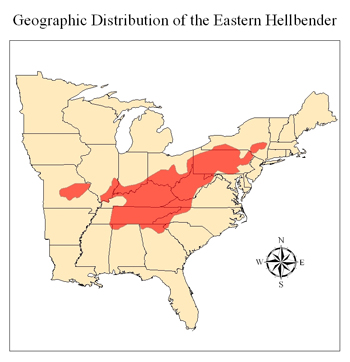 Hellbenders inhabit rivers and streams throughout the eastern United States, including Indiana's Blue River. They require clean, cool, swift-flowing water containing high levels of dissolved oxygen. Because they require high quality water and habitat, their presence can indicate a healthy stream ecosystem.
Hellbenders inhabit rivers and streams throughout the eastern United States, including Indiana's Blue River. They require clean, cool, swift-flowing water containing high levels of dissolved oxygen. Because they require high quality water and habitat, their presence can indicate a healthy stream ecosystem.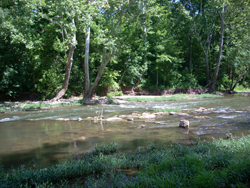 The eastern hellbender has experienced significant declines throughout its geographic range resulting in various levels of protection among state agencies.
The eastern hellbender has experienced significant declines throughout its geographic range resulting in various levels of protection among state agencies.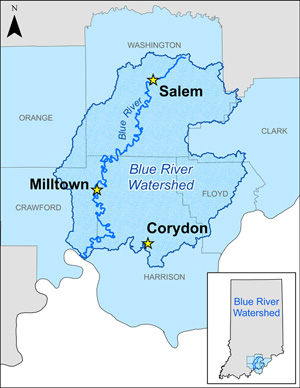 The main stem of the Blue River runs nearly 60 miles before it falls into the Ohio River near Leavenworth. Because much of the flow comes from springs and underground sources, water temperatures remain lower than many other Indiana streams, even during hot summer months. Many of the banks are shaded by large trees, providing additional cooling and structure for fish habitat. The river drops approximately 4 feet per river mile, a gradient that is perfect for canoeists and swift enough to keep many sections relatively free of sediment. The limestone bedrock in the area also provides many crevices for hellbenders and their prey to hide and to thrive. All of these characteristics help provide a suitable living environment for the hellbender.
The main stem of the Blue River runs nearly 60 miles before it falls into the Ohio River near Leavenworth. Because much of the flow comes from springs and underground sources, water temperatures remain lower than many other Indiana streams, even during hot summer months. Many of the banks are shaded by large trees, providing additional cooling and structure for fish habitat. The river drops approximately 4 feet per river mile, a gradient that is perfect for canoeists and swift enough to keep many sections relatively free of sediment. The limestone bedrock in the area also provides many crevices for hellbenders and their prey to hide and to thrive. All of these characteristics help provide a suitable living environment for the hellbender.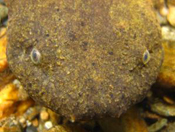 Eastern Hellbenders are aquatic amphibians that spend their entire lives in water. They prefer cool, shallow rivers where rocks are not embedded in sediment or silted in. These conditions exist in many parts of the Blue River
Eastern Hellbenders are aquatic amphibians that spend their entire lives in water. They prefer cool, shallow rivers where rocks are not embedded in sediment or silted in. These conditions exist in many parts of the Blue River
Clean water is important for Hellbenders because they obtain most of their oxygen from the water by “breathing” through their skin. When breathing, their fleshy folds expand in surface area, enabling them to absorb more oxygen from the water.
Adults are typically active at night or on overcast days, and otherwise remain hidden under rocks and other cover. When foraging, hellbenders walk along the bottom searching crevices for prey. Their diet consists almost entirely of crayfish, though they will also eat some small fish and aquatic insects. Hellbenders have small eyes and rely primarily on smell to locate prey.
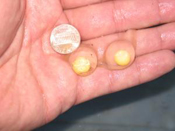 Eastern Hellbenders are one of the few salamander species to externally fertilize eggs. As the female begins to deposit eggs, the male will simultaneously release sperm to fertilize her clutch. Females lay between 100-300 eggs under a male’s nest rock. Individual eggs are attached to each other and have a stringy, beaded appearance resembling a pearl necklace (see the top picture in the diagram below). After egg laying is complete, the male drives off the female and defends the eggs from predators, which include other hellbenders. Eggs hatch into 1-2 inch larvae after 55-75 days. The newly hatched larvae can survive for several months without eating by absorbing nutrients stored in their yolk.
Eastern Hellbenders are one of the few salamander species to externally fertilize eggs. As the female begins to deposit eggs, the male will simultaneously release sperm to fertilize her clutch. Females lay between 100-300 eggs under a male’s nest rock. Individual eggs are attached to each other and have a stringy, beaded appearance resembling a pearl necklace (see the top picture in the diagram below). After egg laying is complete, the male drives off the female and defends the eggs from predators, which include other hellbenders. Eggs hatch into 1-2 inch larvae after 55-75 days. The newly hatched larvae can survive for several months without eating by absorbing nutrients stored in their yolk.
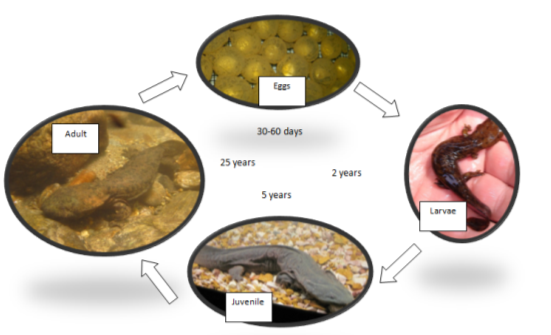 Little is known about the larval life cycle, but they are thought to feed on a variety of aquatic insects and live under gravel and cobble to avoid predators. It is during this larval stage that individuals are the most vulnerable to predation by fish, crayfish, and other aquatic organisms. The larval stage lasts for approximately two years at which point the young undergo a partial transformation. During this life stage, young absorb their gills and begin breathing through their skin. After transformation, juveniles require another three to four years to reach sexual maturity (pictured to the right).
Little is known about the larval life cycle, but they are thought to feed on a variety of aquatic insects and live under gravel and cobble to avoid predators. It is during this larval stage that individuals are the most vulnerable to predation by fish, crayfish, and other aquatic organisms. The larval stage lasts for approximately two years at which point the young undergo a partial transformation. During this life stage, young absorb their gills and begin breathing through their skin. After transformation, juveniles require another three to four years to reach sexual maturity (pictured to the right).
The Issue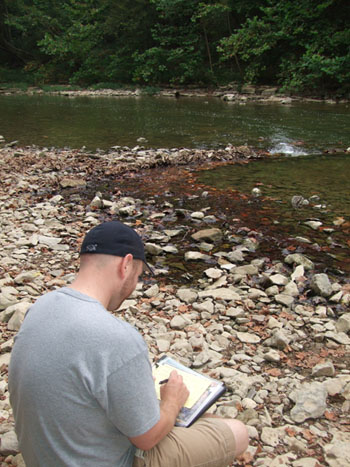 Hellbender populations are declining across their range, from Missouri to New York. This decline, which affects the hellbender population in Indiana's Blue River, is likely caused by human influences such as habitat degradation and destruction. The stream-bottom habitat of hellbenders can be degraded by sediment from eroded banks and fields and destroyed when streams are dammed or dredged. Hellbenders are also captured inadvertently by anglers or purposefully for illegal sale in the pet trade. Finally, emerging diseases may be impacting some populations of hellbenders. Specifically, the chytrid fungus (Batrachochytrium dendrobatidis) and Ranavirus (family Iridoviridae) are considered to be major threats to the persistence of hellbender populations across their range.
Hellbender populations are declining across their range, from Missouri to New York. This decline, which affects the hellbender population in Indiana's Blue River, is likely caused by human influences such as habitat degradation and destruction. The stream-bottom habitat of hellbenders can be degraded by sediment from eroded banks and fields and destroyed when streams are dammed or dredged. Hellbenders are also captured inadvertently by anglers or purposefully for illegal sale in the pet trade. Finally, emerging diseases may be impacting some populations of hellbenders. Specifically, the chytrid fungus (Batrachochytrium dendrobatidis) and Ranavirus (family Iridoviridae) are considered to be major threats to the persistence of hellbender populations across their range.
Conservation Efforts
Many states are developing conservation programs to help the hellbender. These conservation initiatives are diverse and consist of captive breeding and head-starting programs, education programs that promote awareness, increased protection through state and federal regulations, and strong research collaborations between academic institutions and government agencies (Hellbender Conservation, Hellbender Public Attitudes, and Hellbender Repatriation). Most recently, the Ozark hellbender subspecies, C. a. bishopi, was given protection as federally-listed endangered species. For more information view our Conservation Efforts.
For more information on what you can do to help, visit the anglers, homeowners, farmers, teachers, and kids web pages. found at the top of each page give information about how individuals from each one of these groups can help the hellbender.
- Pisgah brewing 2016 hellbender will benefit wild south
The Full Pint - Help the hellbenders: Don't move the rocks
Citizen-Times - Nonprofit aims to help embattled amphibian recover
The Daily Star - Local salamander conservation focus of AU lecture
Richland Source - Historic hellbender hatches
Nashville Zoo - Scientists find a 200 year old salamander just chilling
MSN News - The hellbender: an original member of the Ozarks community
KSMU Ozarks Public Radio - Cupid's syringe: a love potion for troubled amphibians
Mongabay Wildtech - Hot on the Alabama trail of the elusive hellbender
The Wildlife Society - Toledo zoo and Penta partner to help threatened hellbender salamanders
NBC 24 - Outdoors: Stories of Pennsylvania's largest salamander
The Sentinel - Chattanooga zoo announces baby hellbenders
The Chattanoogan - Fort Wayne Children’s Zoo to help rear rare hellbenders
KPC News - Saint Louis Zoo shares secrets of salamander love at hellbender symposium
St. Louis Public Radio - News about hellbenders reaches the northeastern US
Maine Dept. of Inland Fisheries & Wildlife - Purdue-Zoo Partnership Aims to Save the Hellbender
WLFI - Purdue part of national group bent on saving the hellbender
Purdue News
